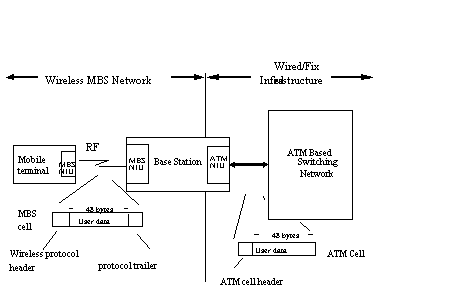
Figure: ATM-compatible
MBS approach
With enormous complexity of managing
and operating the many different types of networks that are now
in use, the door is open for finding a common platform - a network
on which all established services can be supported and which will
allow new services to be introduced without needing new networks
to run them on. The answer seems to be asynchronous transfer mode
(ATM). This is the technology being defined and standardised for
broadband integrated services digital network (B-ISDN). Thus,
ATM, when adequately modified, is also an answer for the future
mobile wireless broadband multimedia systems.
ATM is a packet oriented transmission
scheme. The transmission path of the packets of constant length,
the so called ATM-Cells, will be established during connection
set-up between the two end-points by assigning a virtual channel.
At this time, the necessary resources are provided and the logical
channels are assigned. All packets of a virtual channel are carried
over the same path. The transmission capacity of virtual channel
are characterised by the parameters mean bit rate and peak bit
rate during connection set-up. ATM-Cells are generated according
to the need of data source. Thus, ATM is a very good method to
meet dynamic requirements of connections with variable data rates.
MBS will be the interface between
the fixed ATM-Net at the base station side and mobile ATM-Net
at the mobile station side. Normally, the ATM-Net at the mobile
station side will only consist of one end system. For every end
station it is possible to operate several virtual channels with
different data rates at the same time.
Most important benefit of ATM is its flexibility, it can be used for the new high bit rate services which are either variable bit rate (VBR) or burst traffic. Several factors that tend to favour the use of ATM cell transport in MBS, can be given as follows:

Figure: ATM-compatible
MBS approach
For a seamless internetworking mechanism
with the wired broadband network it is vital to have the MBS protocol
layering harmonised with the ATM stack.
In the protocol
reference model, new wireless channel
specific physical, medium access control and data-link layers
are added below the ATM network layer. This means that regular
network layer and control services such as call set-up, virtual
channel identifier/virtual path identifier (VCI/VPI) addressing,
cell prioritisation and flow-control indication will continue
to be used by mobile services. While, the baseline ATM network
and signalling protocol will have to be specified to specific
mobility related functions such as address registration (roaming),
broadcasting, hand-off etc.